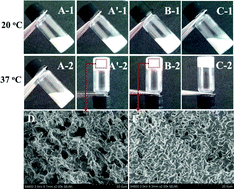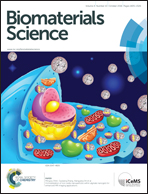Temperature-responsive in situ nanoparticle hydrogels based on hydrophilic pendant cyclic ether modified PEG-PCL-PEG
Abstract
Thermo-sensitive injectable hydrogels based on poly(ε-caprolactone)/poly(ethylene glycol) (PCL/PEG) block copolymers have attracted considerable attention for sustained drug release and tissue engineering applications. Previously, we have reported a thermo-sensitive hydrogel of P(CL-co-TOSUO)-PEG-P(CL-co-TOSUO) (PECT) triblock copolymers modified by hydrophilic cyclic ether pendant groups 1,4,8-trioxa-[4.6]spiro-9-undecanone (TOSUO). Unfortunately, the low gel modulus of PECT (only 50–70 Pa) may limit its applications. Herein, another kind of thermogelling triblock copolymer of a pendant cyclic ether-modified caprolactonic poloxamer analog, PEG-P(CL-co-TOSUO)-PEG (PECTE), was successfully prepared by control of the hydrophilicity/hydrophobicity balance and chemical compositions of the copolymers. PECTE powder could directly disperse in water to form a stable nanoparticle (NP) aqueous dispersion and underwent sol–gel–sol transition behavior at a higher concentration with the temperature increasing from ambient or lower temperatures. Significantly, the microstructure parameters (e.g., different chemical compositions of the hydrophobic block and topology) played a critical role in the phase transition behavior. Furthermore, comparison studies on PECTE and PEG-PCL-PEG (PECE) showed that the introduction of pendant cyclic ether groups into PCL blocks could avoid unexpected ahead-of-time gelling of the PECE aqueous solution. In addition, the rheological analysis of PECTE and PECT indicated that the storage modulus of the PECTE hydrogel could be 100 times greater than that of the PECT hydrogel under the same mole ratios of TOSUO/CL and lower molecular weight. Consequently, PECTE thermal hydrogel systems are believed to be promising as in situ gel-forming biomaterials for drug delivery and tissue engineering.


 Please wait while we load your content...
Please wait while we load your content...